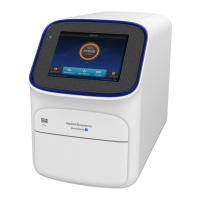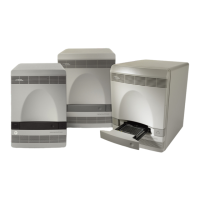Glossary
Glossary
Plot of the re-scaled melt curve.
In a diploid organism, one of two DNA sequences found at the same locus (for
example, a particular gene), but located on homologous chromosomes. Two
corresponding alleles may have the identical sequence, or they may dier somewhat,
often at one or more single-base sites (SNPs).
A segment of DNA amplied during PCR.
Part of the instrument run in which PCR amplies the target. Fluorescence data
collected during amplication are displayed in an Amplication Plot, and the data are
used to calculate results.
Note: Only quantitative real-time PCR experiments, not end-point experiments, take
amplication data into account.
Calculation of the eciency of the PCR amplication in an experiment. EFF% is
calculated using the slope of the regression line in the standard curve. A slope close to
–3.32 indicates optimal, 100% PCR amplication eciency.
Display of data collected during the cycling stage of PCR amplication. The
Amplication Plot can be viewed as:
• Baseline-corrected normalized reporter (ΔR
n
) vs. cycle
• Normalized reporter (R
n
) vs. cycle
• Threshold cycle (C
t
) vs. well
Part of the instrument run in which PCR amplies the target. The amplication stage,
called a cycling stage in the thermal prole, consists of denaturing, primer annealing,
and extension steps that are repeated. Fluorescence data collected during the
extension stage are displayed in an amplication plot, and the data are used to
calculate results. With chemistry, the last two steps of a PCR stage are typically
combined.
See also “cycling stage“ on page 185.
In a PCR reaction mix, two target-specic primers or two primers and a probe used to
amplify a target.
aligned melt curve
plot
allele
amplicon
amplification
amplification
efficiency (EFF%)
Amplification Plot
amplification
stage
assay
184
QuantStudio
™
6 and 7 Flex Real-Time PCR Systems v1.6 Maintenance and Administration Guide
